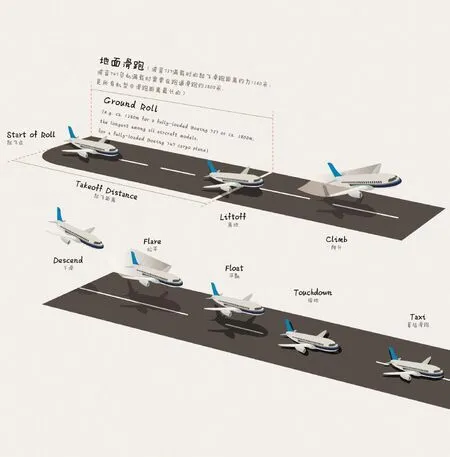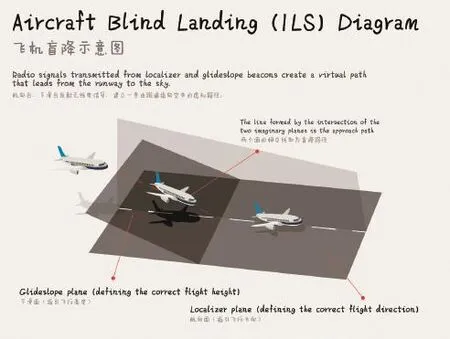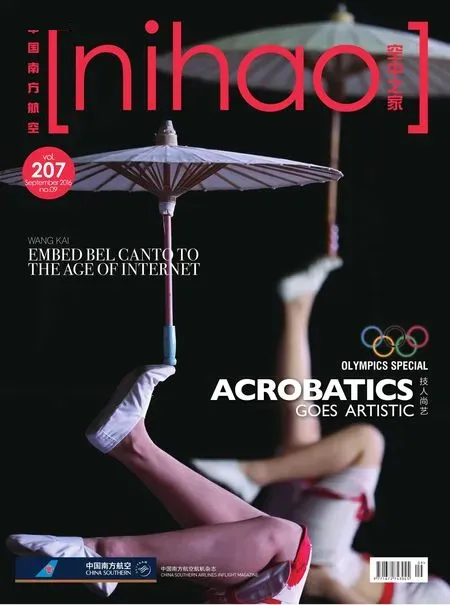THE SECRET OF TAKEOFF AND LANDING
THE SECRET OF TAKEOFF AND LANDING
The 6 or 7 minutes during takeoff or landing are the most critical times for any fl ight. Pilots must be trained hundreds, if not thousands, of times in each operation and have everything carefully calculated to make it a success. What are the little-known secrets behind takeoffs and landings?
Text by Yunshi Wu Translation by Leo Illustrations by Haolun Zhang

飞机起降的奥秘
在飞行过程中,起飞6分钟和降落7分钟是最敏感最关键的时段。飞机起降的每一个角度,都经过飞行员千百次的计算和千百次的训练,每一个动作,背后都有鲜为人知的奥妙。

Lift it up
An aircraft uses the lift generated by its wings to become airborne while taxiing on the runway.
A relative speed between the airplane and air is produced as the airplane gains speed due to the thrust generated by its engines. Because of the streamlined shape of the wings, air travels slower under them and faster over them, creating a higher pressure under them and a lower pressure above them. This is how lift is generated.
At a certain point during takeoff, the pilot will pull back on the control stick to defl ect the elevators up. To reduce takeoff speed and shorten the takeoff roll, the pilot will lift the nose gear (so that the aircraft is in a two-point attitude) to increase the angle of attack and lift coeffi cient of the wings, when the aircraft reaches a certain speed. This must be done when the airplane reaches the right speed, or a tail strike may occur.
Landing
Aircraft landing involves more complicated manoeuvres than takeoff does as more changes occur at a faster pace during the process.
The basic idea of landing is to bring down the engine thrust, the aircraft speed and the speed of airfl ow over the wings. At landing, the engines idle; and the pilot must slow the forward speed and the rate of descent, while avoiding stalled engines, in order for the airplane to touch down at the approach end of the runway in time. In the process, fl aps and slats are often used to change the aircraft shape and the angle of descent.
Blind landing
“Blind landing” is a process in which a pilot is forced to land an airplane in cloudy or otherwise low-visibility conditions when the runway is not clear, relying on radio signals and high-intensity light arrays. Blind landing systems are needed to guide the plane to a safe landing. Two alternative systems are often available at mainstream airports to guide the aircraft down to 30 metres above the ground, where the pilot can see the runway.
升力起飞
飞机从地面滑跑到离地升空,凭借的是机翼产生的升力。
发动机带来的推力给予飞机快速向前运动的速度,使飞机与空气产生了相对运动。由于机翼的流线体设计,空气流经机翼上下速度不一,上下表面产生压力差,从而产生了向上的升力。
起飞时,飞行员会有一个拉杆动作,以控制飞机尾部的水平升降舵。为减小离地速度,缩短滑跑距离,当飞机速度增大到一定程度时需要抬前轮作两点姿态滑跑,以增大迎角和升力系数。飞行员必须在正确的速度下抬前轮,速度过大或过小,都可能导致飞机擦尾。
着陆原理
飞机降落的操作更难于起飞,降落是飞机变化最多最快的阶段。
飞机降落原理是减小发动机的推力,使飞机速度减小,从而减小空气流经机翼的速度。此时发动机处于慢车工作,飞行员必须控制飞机在一个缓慢的速度下,一边向前飞行一边下降,避免失速,争取在跑道头接地。其间要放襟翼和缝翼,改变飞机外形,调整下降角度。
特殊盲降
盲降是在低云、低能见度的仪表气象条件下,飞行员无法辨清跑道时进行,使用无线电信号及高强度灯光阵列来引导飞机安全降落的着陆系统,也称为“盲降系统”。现在主流机场都有二类盲降系统,可以引导飞机下降到30米,飞行员见到跑道后再进行着陆。

